Global Business Strategies Report 2022
VerifiedAdded on 2022/10/01
|8
|1872
|9
AI Summary
Contribute Materials
Your contribution can guide someone’s learning journey. Share your
documents today.

Global business strategies
Secure Best Marks with AI Grader
Need help grading? Try our AI Grader for instant feedback on your assignments.
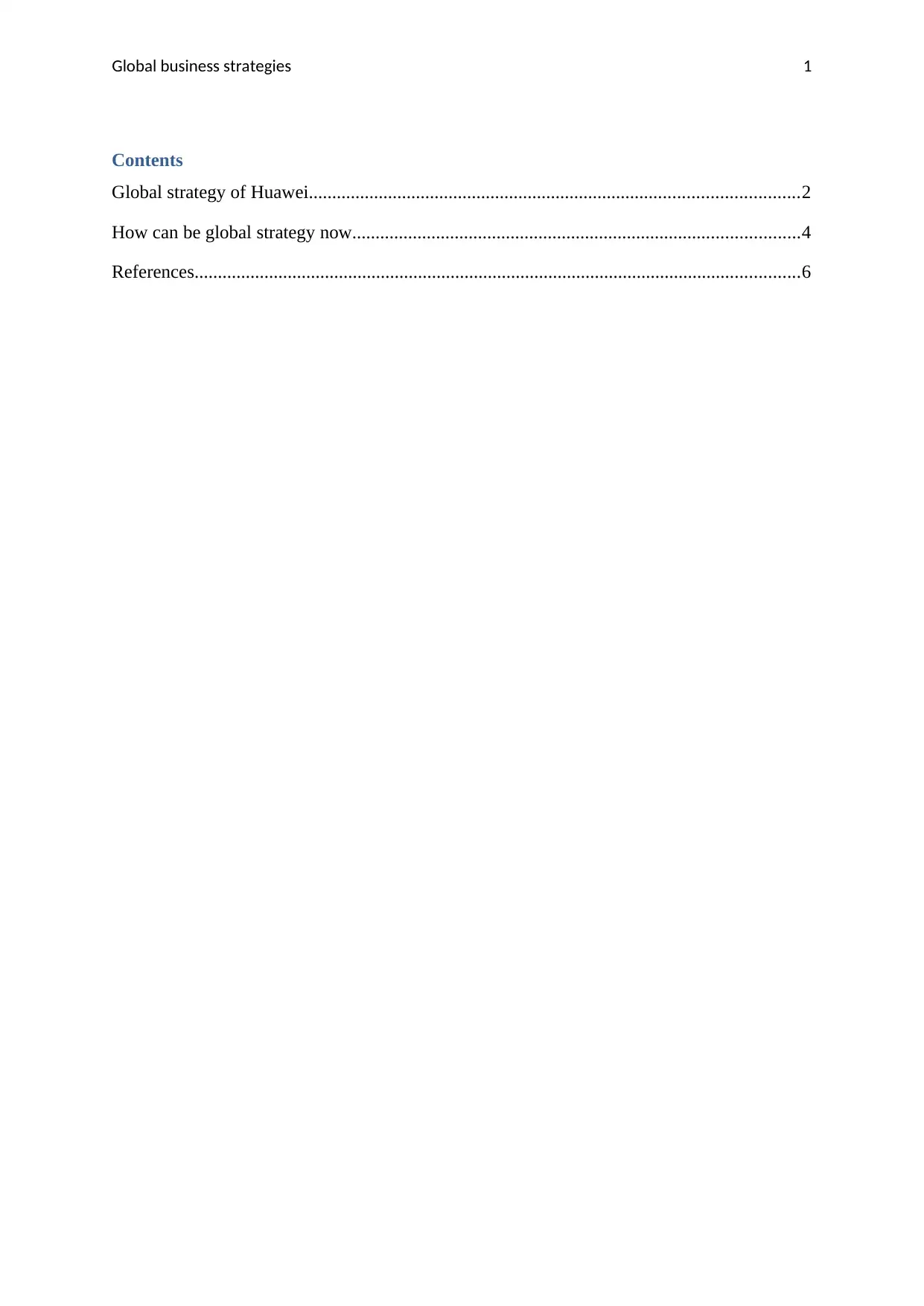
Global business strategies 1
Contents
Global strategy of Huawei.........................................................................................................2
How can be global strategy now................................................................................................4
References..................................................................................................................................6
Contents
Global strategy of Huawei.........................................................................................................2
How can be global strategy now................................................................................................4
References..................................................................................................................................6
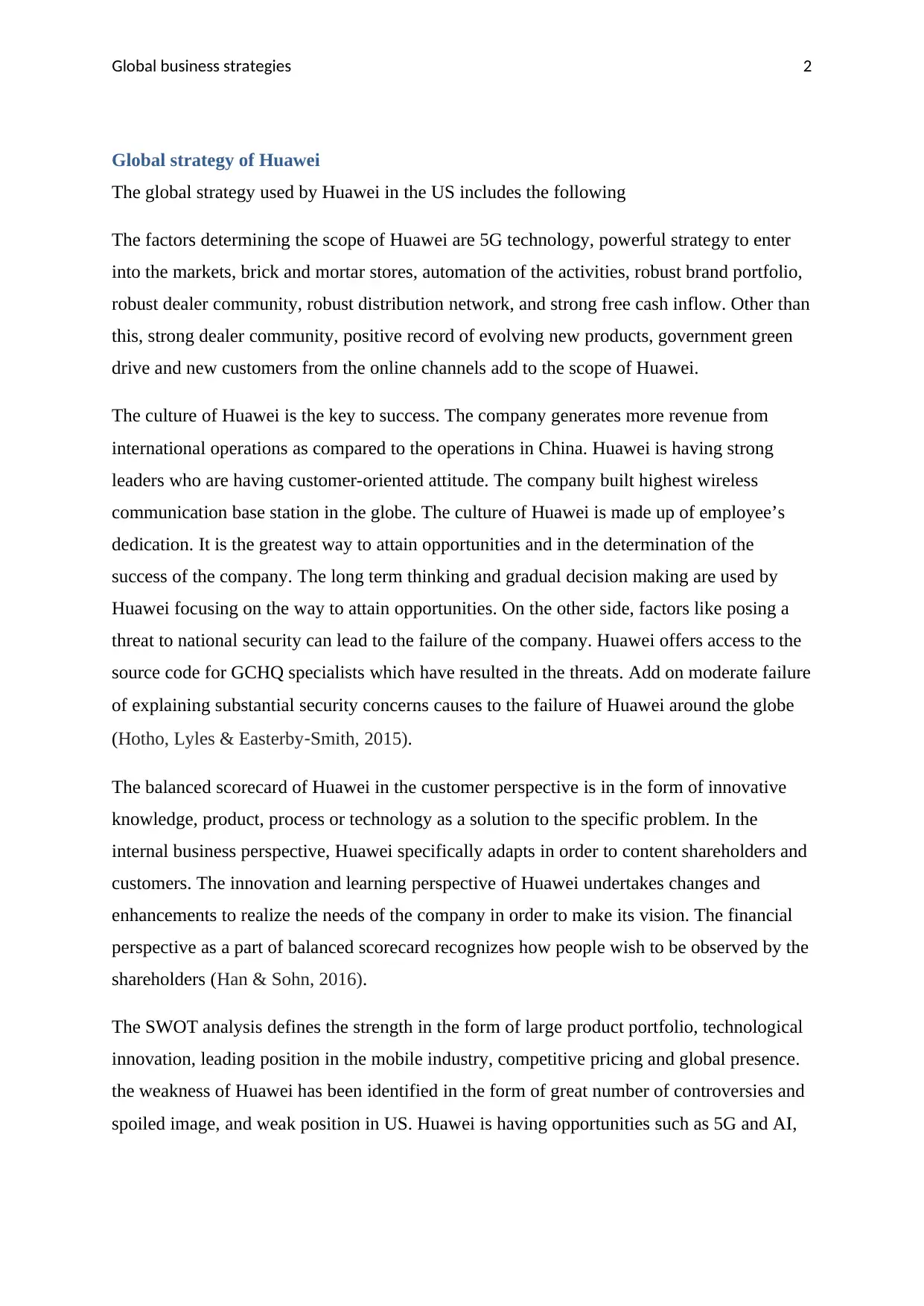
Global business strategies 2
Global strategy of Huawei
The global strategy used by Huawei in the US includes the following
The factors determining the scope of Huawei are 5G technology, powerful strategy to enter
into the markets, brick and mortar stores, automation of the activities, robust brand portfolio,
robust dealer community, robust distribution network, and strong free cash inflow. Other than
this, strong dealer community, positive record of evolving new products, government green
drive and new customers from the online channels add to the scope of Huawei.
The culture of Huawei is the key to success. The company generates more revenue from
international operations as compared to the operations in China. Huawei is having strong
leaders who are having customer-oriented attitude. The company built highest wireless
communication base station in the globe. The culture of Huawei is made up of employee’s
dedication. It is the greatest way to attain opportunities and in the determination of the
success of the company. The long term thinking and gradual decision making are used by
Huawei focusing on the way to attain opportunities. On the other side, factors like posing a
threat to national security can lead to the failure of the company. Huawei offers access to the
source code for GCHQ specialists which have resulted in the threats. Add on moderate failure
of explaining substantial security concerns causes to the failure of Huawei around the globe
(Hotho, Lyles & Easterby‐Smith, 2015).
The balanced scorecard of Huawei in the customer perspective is in the form of innovative
knowledge, product, process or technology as a solution to the specific problem. In the
internal business perspective, Huawei specifically adapts in order to content shareholders and
customers. The innovation and learning perspective of Huawei undertakes changes and
enhancements to realize the needs of the company in order to make its vision. The financial
perspective as a part of balanced scorecard recognizes how people wish to be observed by the
shareholders (Han & Sohn, 2016).
The SWOT analysis defines the strength in the form of large product portfolio, technological
innovation, leading position in the mobile industry, competitive pricing and global presence.
the weakness of Huawei has been identified in the form of great number of controversies and
spoiled image, and weak position in US. Huawei is having opportunities such as 5G and AI,
Global strategy of Huawei
The global strategy used by Huawei in the US includes the following
The factors determining the scope of Huawei are 5G technology, powerful strategy to enter
into the markets, brick and mortar stores, automation of the activities, robust brand portfolio,
robust dealer community, robust distribution network, and strong free cash inflow. Other than
this, strong dealer community, positive record of evolving new products, government green
drive and new customers from the online channels add to the scope of Huawei.
The culture of Huawei is the key to success. The company generates more revenue from
international operations as compared to the operations in China. Huawei is having strong
leaders who are having customer-oriented attitude. The company built highest wireless
communication base station in the globe. The culture of Huawei is made up of employee’s
dedication. It is the greatest way to attain opportunities and in the determination of the
success of the company. The long term thinking and gradual decision making are used by
Huawei focusing on the way to attain opportunities. On the other side, factors like posing a
threat to national security can lead to the failure of the company. Huawei offers access to the
source code for GCHQ specialists which have resulted in the threats. Add on moderate failure
of explaining substantial security concerns causes to the failure of Huawei around the globe
(Hotho, Lyles & Easterby‐Smith, 2015).
The balanced scorecard of Huawei in the customer perspective is in the form of innovative
knowledge, product, process or technology as a solution to the specific problem. In the
internal business perspective, Huawei specifically adapts in order to content shareholders and
customers. The innovation and learning perspective of Huawei undertakes changes and
enhancements to realize the needs of the company in order to make its vision. The financial
perspective as a part of balanced scorecard recognizes how people wish to be observed by the
shareholders (Han & Sohn, 2016).
The SWOT analysis defines the strength in the form of large product portfolio, technological
innovation, leading position in the mobile industry, competitive pricing and global presence.
the weakness of Huawei has been identified in the form of great number of controversies and
spoiled image, and weak position in US. Huawei is having opportunities such as 5G and AI,
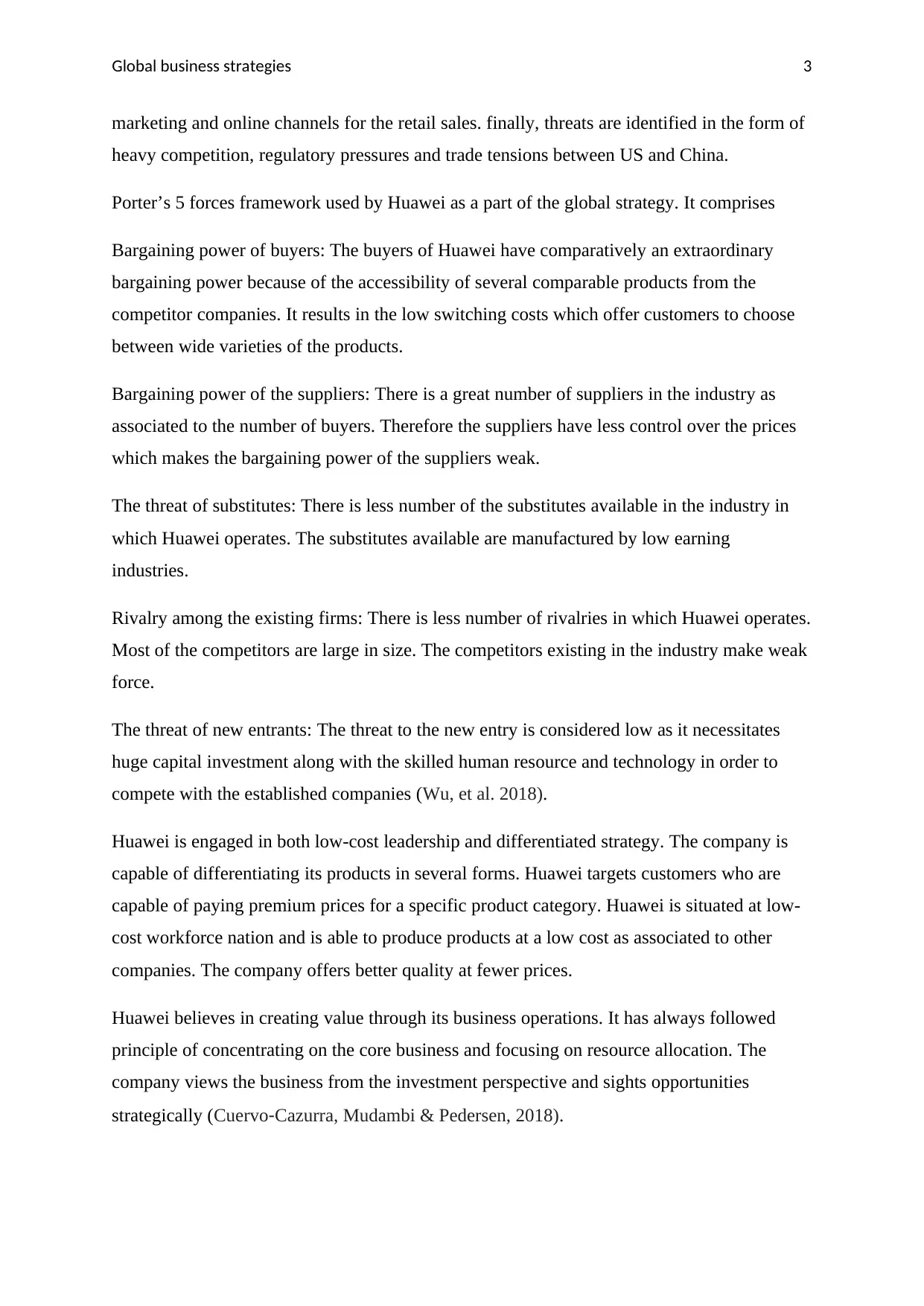
Global business strategies 3
marketing and online channels for the retail sales. finally, threats are identified in the form of
heavy competition, regulatory pressures and trade tensions between US and China.
Porter’s 5 forces framework used by Huawei as a part of the global strategy. It comprises
Bargaining power of buyers: The buyers of Huawei have comparatively an extraordinary
bargaining power because of the accessibility of several comparable products from the
competitor companies. It results in the low switching costs which offer customers to choose
between wide varieties of the products.
Bargaining power of the suppliers: There is a great number of suppliers in the industry as
associated to the number of buyers. Therefore the suppliers have less control over the prices
which makes the bargaining power of the suppliers weak.
The threat of substitutes: There is less number of the substitutes available in the industry in
which Huawei operates. The substitutes available are manufactured by low earning
industries.
Rivalry among the existing firms: There is less number of rivalries in which Huawei operates.
Most of the competitors are large in size. The competitors existing in the industry make weak
force.
The threat of new entrants: The threat to the new entry is considered low as it necessitates
huge capital investment along with the skilled human resource and technology in order to
compete with the established companies (Wu, et al. 2018).
Huawei is engaged in both low-cost leadership and differentiated strategy. The company is
capable of differentiating its products in several forms. Huawei targets customers who are
capable of paying premium prices for a specific product category. Huawei is situated at low-
cost workforce nation and is able to produce products at a low cost as associated to other
companies. The company offers better quality at fewer prices.
Huawei believes in creating value through its business operations. It has always followed
principle of concentrating on the core business and focusing on resource allocation. The
company views the business from the investment perspective and sights opportunities
strategically (Cuervo‐Cazurra, Mudambi & Pedersen, 2018).
marketing and online channels for the retail sales. finally, threats are identified in the form of
heavy competition, regulatory pressures and trade tensions between US and China.
Porter’s 5 forces framework used by Huawei as a part of the global strategy. It comprises
Bargaining power of buyers: The buyers of Huawei have comparatively an extraordinary
bargaining power because of the accessibility of several comparable products from the
competitor companies. It results in the low switching costs which offer customers to choose
between wide varieties of the products.
Bargaining power of the suppliers: There is a great number of suppliers in the industry as
associated to the number of buyers. Therefore the suppliers have less control over the prices
which makes the bargaining power of the suppliers weak.
The threat of substitutes: There is less number of the substitutes available in the industry in
which Huawei operates. The substitutes available are manufactured by low earning
industries.
Rivalry among the existing firms: There is less number of rivalries in which Huawei operates.
Most of the competitors are large in size. The competitors existing in the industry make weak
force.
The threat of new entrants: The threat to the new entry is considered low as it necessitates
huge capital investment along with the skilled human resource and technology in order to
compete with the established companies (Wu, et al. 2018).
Huawei is engaged in both low-cost leadership and differentiated strategy. The company is
capable of differentiating its products in several forms. Huawei targets customers who are
capable of paying premium prices for a specific product category. Huawei is situated at low-
cost workforce nation and is able to produce products at a low cost as associated to other
companies. The company offers better quality at fewer prices.
Huawei believes in creating value through its business operations. It has always followed
principle of concentrating on the core business and focusing on resource allocation. The
company views the business from the investment perspective and sights opportunities
strategically (Cuervo‐Cazurra, Mudambi & Pedersen, 2018).
Secure Best Marks with AI Grader
Need help grading? Try our AI Grader for instant feedback on your assignments.
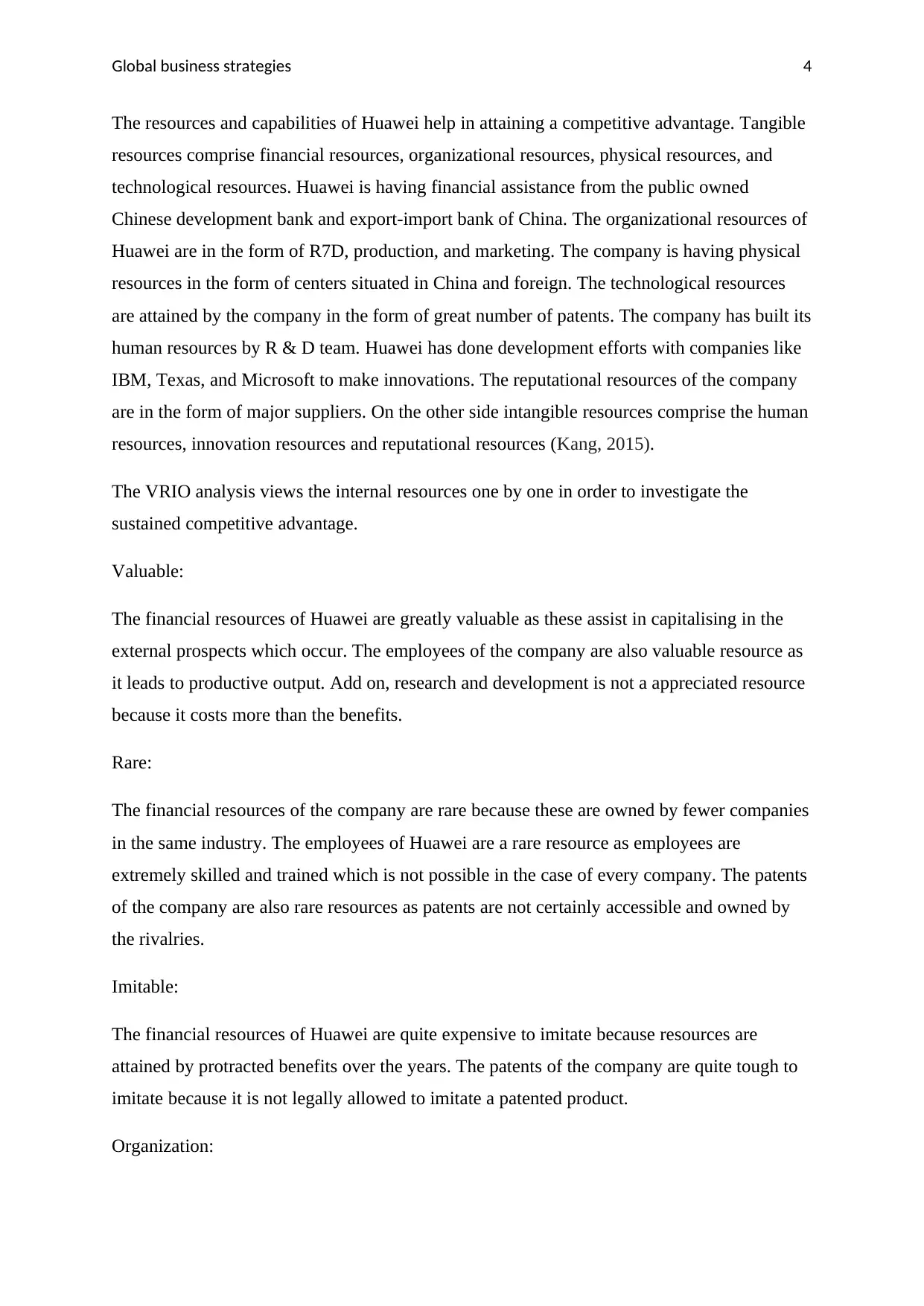
Global business strategies 4
The resources and capabilities of Huawei help in attaining a competitive advantage. Tangible
resources comprise financial resources, organizational resources, physical resources, and
technological resources. Huawei is having financial assistance from the public owned
Chinese development bank and export-import bank of China. The organizational resources of
Huawei are in the form of R7D, production, and marketing. The company is having physical
resources in the form of centers situated in China and foreign. The technological resources
are attained by the company in the form of great number of patents. The company has built its
human resources by R & D team. Huawei has done development efforts with companies like
IBM, Texas, and Microsoft to make innovations. The reputational resources of the company
are in the form of major suppliers. On the other side intangible resources comprise the human
resources, innovation resources and reputational resources (Kang, 2015).
The VRIO analysis views the internal resources one by one in order to investigate the
sustained competitive advantage.
Valuable:
The financial resources of Huawei are greatly valuable as these assist in capitalising in the
external prospects which occur. The employees of the company are also valuable resource as
it leads to productive output. Add on, research and development is not a appreciated resource
because it costs more than the benefits.
Rare:
The financial resources of the company are rare because these are owned by fewer companies
in the same industry. The employees of Huawei are a rare resource as employees are
extremely skilled and trained which is not possible in the case of every company. The patents
of the company are also rare resources as patents are not certainly accessible and owned by
the rivalries.
Imitable:
The financial resources of Huawei are quite expensive to imitate because resources are
attained by protracted benefits over the years. The patents of the company are quite tough to
imitate because it is not legally allowed to imitate a patented product.
Organization:
The resources and capabilities of Huawei help in attaining a competitive advantage. Tangible
resources comprise financial resources, organizational resources, physical resources, and
technological resources. Huawei is having financial assistance from the public owned
Chinese development bank and export-import bank of China. The organizational resources of
Huawei are in the form of R7D, production, and marketing. The company is having physical
resources in the form of centers situated in China and foreign. The technological resources
are attained by the company in the form of great number of patents. The company has built its
human resources by R & D team. Huawei has done development efforts with companies like
IBM, Texas, and Microsoft to make innovations. The reputational resources of the company
are in the form of major suppliers. On the other side intangible resources comprise the human
resources, innovation resources and reputational resources (Kang, 2015).
The VRIO analysis views the internal resources one by one in order to investigate the
sustained competitive advantage.
Valuable:
The financial resources of Huawei are greatly valuable as these assist in capitalising in the
external prospects which occur. The employees of the company are also valuable resource as
it leads to productive output. Add on, research and development is not a appreciated resource
because it costs more than the benefits.
Rare:
The financial resources of the company are rare because these are owned by fewer companies
in the same industry. The employees of Huawei are a rare resource as employees are
extremely skilled and trained which is not possible in the case of every company. The patents
of the company are also rare resources as patents are not certainly accessible and owned by
the rivalries.
Imitable:
The financial resources of Huawei are quite expensive to imitate because resources are
attained by protracted benefits over the years. The patents of the company are quite tough to
imitate because it is not legally allowed to imitate a patented product.
Organization:
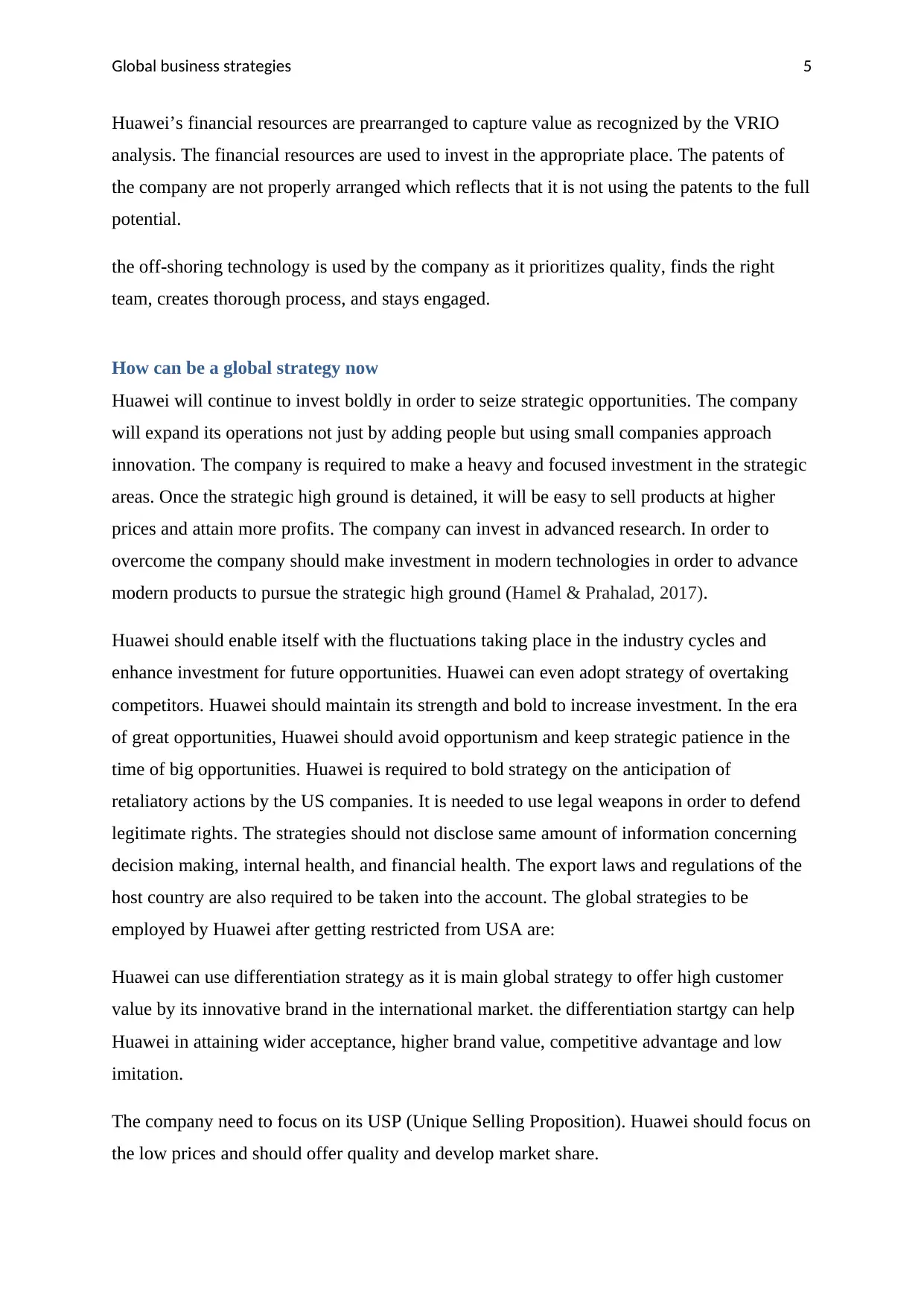
Global business strategies 5
Huawei’s financial resources are prearranged to capture value as recognized by the VRIO
analysis. The financial resources are used to invest in the appropriate place. The patents of
the company are not properly arranged which reflects that it is not using the patents to the full
potential.
the off-shoring technology is used by the company as it prioritizes quality, finds the right
team, creates thorough process, and stays engaged.
How can be a global strategy now
Huawei will continue to invest boldly in order to seize strategic opportunities. The company
will expand its operations not just by adding people but using small companies approach
innovation. The company is required to make a heavy and focused investment in the strategic
areas. Once the strategic high ground is detained, it will be easy to sell products at higher
prices and attain more profits. The company can invest in advanced research. In order to
overcome the company should make investment in modern technologies in order to advance
modern products to pursue the strategic high ground (Hamel & Prahalad, 2017).
Huawei should enable itself with the fluctuations taking place in the industry cycles and
enhance investment for future opportunities. Huawei can even adopt strategy of overtaking
competitors. Huawei should maintain its strength and bold to increase investment. In the era
of great opportunities, Huawei should avoid opportunism and keep strategic patience in the
time of big opportunities. Huawei is required to bold strategy on the anticipation of
retaliatory actions by the US companies. It is needed to use legal weapons in order to defend
legitimate rights. The strategies should not disclose same amount of information concerning
decision making, internal health, and financial health. The export laws and regulations of the
host country are also required to be taken into the account. The global strategies to be
employed by Huawei after getting restricted from USA are:
Huawei can use differentiation strategy as it is main global strategy to offer high customer
value by its innovative brand in the international market. the differentiation startgy can help
Huawei in attaining wider acceptance, higher brand value, competitive advantage and low
imitation.
The company need to focus on its USP (Unique Selling Proposition). Huawei should focus on
the low prices and should offer quality and develop market share.
Huawei’s financial resources are prearranged to capture value as recognized by the VRIO
analysis. The financial resources are used to invest in the appropriate place. The patents of
the company are not properly arranged which reflects that it is not using the patents to the full
potential.
the off-shoring technology is used by the company as it prioritizes quality, finds the right
team, creates thorough process, and stays engaged.
How can be a global strategy now
Huawei will continue to invest boldly in order to seize strategic opportunities. The company
will expand its operations not just by adding people but using small companies approach
innovation. The company is required to make a heavy and focused investment in the strategic
areas. Once the strategic high ground is detained, it will be easy to sell products at higher
prices and attain more profits. The company can invest in advanced research. In order to
overcome the company should make investment in modern technologies in order to advance
modern products to pursue the strategic high ground (Hamel & Prahalad, 2017).
Huawei should enable itself with the fluctuations taking place in the industry cycles and
enhance investment for future opportunities. Huawei can even adopt strategy of overtaking
competitors. Huawei should maintain its strength and bold to increase investment. In the era
of great opportunities, Huawei should avoid opportunism and keep strategic patience in the
time of big opportunities. Huawei is required to bold strategy on the anticipation of
retaliatory actions by the US companies. It is needed to use legal weapons in order to defend
legitimate rights. The strategies should not disclose same amount of information concerning
decision making, internal health, and financial health. The export laws and regulations of the
host country are also required to be taken into the account. The global strategies to be
employed by Huawei after getting restricted from USA are:
Huawei can use differentiation strategy as it is main global strategy to offer high customer
value by its innovative brand in the international market. the differentiation startgy can help
Huawei in attaining wider acceptance, higher brand value, competitive advantage and low
imitation.
The company need to focus on its USP (Unique Selling Proposition). Huawei should focus on
the low prices and should offer quality and develop market share.

Global business strategies 6
Huawei can design a better customer experience by unwrapping new products and uploasing
a video on the YouTube. It goes beyond the actual purchase. The customer experience will
comprise elemenst of every aspect of the purchasing process.
Huawei can design a better customer experience by unwrapping new products and uploasing
a video on the YouTube. It goes beyond the actual purchase. The customer experience will
comprise elemenst of every aspect of the purchasing process.
Paraphrase This Document
Need a fresh take? Get an instant paraphrase of this document with our AI Paraphraser

Global business strategies 7
References
Cuervo‐Cazurra, A., Mudambi, R., & Pedersen, T. (2018). The boundaries of the firm in
global strategy. Global Strategy Journal, 8(2), 211-219.
Hamel, G., & Prahalad, C. K. (2017). Do you really have a global strategy?. In International
Business (pp. 285-294). Routledge.
Han, E. J., & Sohn, S. Y. (2016). Technological convergence in standards for information and
communication technologies. Technological forecasting and social change, 106, 1-10.
Hotho, J. J., Lyles, M. A., & Easterby‐Smith, M. (2015). The mutual impact of global
strategy and organizational learning: Current themes and future directions. Global
Strategy Journal, 5(2), 85-112.
Kang, B. (2015). The innovation process of Huawei and ZTE: Patent data analysis. China
Economic Review, 36, 378-393.
Wu, J., Guo, S., Huang, H., Liu, W., & Xiang, Y. (2018). Information and communications
technologies for sustainable development goals: state-of-the-art, needs and
perspectives. IEEE Communications Surveys & Tutorials, 20(3), 2389-2406.
References
Cuervo‐Cazurra, A., Mudambi, R., & Pedersen, T. (2018). The boundaries of the firm in
global strategy. Global Strategy Journal, 8(2), 211-219.
Hamel, G., & Prahalad, C. K. (2017). Do you really have a global strategy?. In International
Business (pp. 285-294). Routledge.
Han, E. J., & Sohn, S. Y. (2016). Technological convergence in standards for information and
communication technologies. Technological forecasting and social change, 106, 1-10.
Hotho, J. J., Lyles, M. A., & Easterby‐Smith, M. (2015). The mutual impact of global
strategy and organizational learning: Current themes and future directions. Global
Strategy Journal, 5(2), 85-112.
Kang, B. (2015). The innovation process of Huawei and ZTE: Patent data analysis. China
Economic Review, 36, 378-393.
Wu, J., Guo, S., Huang, H., Liu, W., & Xiang, Y. (2018). Information and communications
technologies for sustainable development goals: state-of-the-art, needs and
perspectives. IEEE Communications Surveys & Tutorials, 20(3), 2389-2406.
1 out of 8
Related Documents
Your All-in-One AI-Powered Toolkit for Academic Success.
+13062052269
info@desklib.com
Available 24*7 on WhatsApp / Email
![[object Object]](/_next/static/media/star-bottom.7253800d.svg)
Unlock your academic potential
© 2024 | Zucol Services PVT LTD | All rights reserved.





